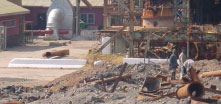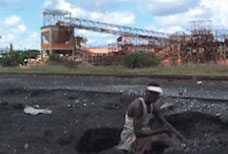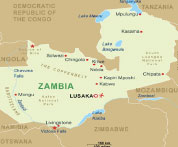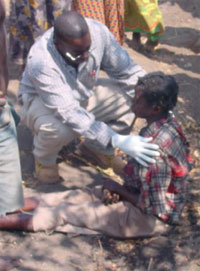Lead Smelter Cleanup
Kabwe

Kabwe, the second largest city in Zambia, has a population of 300,000. It is located about 130km north of the nation’s capital, Lusaka. It is one of six cities situated around the “Copperbelt,” which was once Zambia’s thriving industrial base. In 1902, rich deposits of lead were discovered in the mine and a smelter was constructed in the center of the town. Ore veins with lead concentrations as high as 20% have been mined deep into the earth, and a smelting operation was set up to process the ore. Mining and smelting operations were running almost continuously until 1994 without the government addressing the potential danger of lead. The mine and smelter, owned by the now-privatized Zambia Consolidated Copper Mines, are no longer operating, but have left a city with hazardous concentrations of lead in soil and water.
While in operation, there were no pollution laws regulating emissions from the mine and smelter. In turn, air, soil, and vegetation were all subject to contamination, and ultimately, over decades, millions of lives were affected. Recent findings reveal the extent to which lead has affected the health of Kabwe citizens. In Kabwe, blood-lead concentrations of 300 μg/dL have been recorded in children, and records show average blood-lead levels were between 60 and 120 μg/dL.


Project Strategies
Kabwe’s decades of contamination required a complex cleanup strategy. Blacksmith Institute has helped the situation by establishing a local NGO, Kabwe Environmental and Rehabilitation Foundation (KERF), whose function is to bring educational and healthcare services into each community. At Blacksmith and KERF’s urging, the World Bank provided a $15 million grant for cleanup purposes, and a subsequent $5 million in funding also was secured from the Nordic Development Fund. These results demonstrate that Blacksmith’s initiatives can be leveraged to enable large contributions from major global institutions to allow for the remediation of serious pollution-related problems.
With Blacksmith providing technical assistance and resources, the government’s Copperbelt Environment Project (CEP) has worked to determine the magnitude, sources, and pathways of human lead exposure, as well as to improve public awareness in order to end future contamination. In 2003, they began educational outreach to inform the public of behavioral and hygiene changes that would reduce their risk of lead exposure; at times, these have proven to be as simple as preventing children from playing in the dirt and rinsing dust off plates before meals. CEP has also revealed the critical importance of empowering local citizens with better access to clean water, which will free them from reliance on tainted sources. Some areas of Kabwe required drastic remediation, at times calling for entire neighborhoods to relocate. The CEP has conducted a cleanup of the highest threat level contaminated soils, including a contaminated canal and a great number of toxic hotspots in neighborhoods throughout the city.
The CEP is implementing a comprehensive program on risk communication and humanitarian development. Since its inception, the CEP has been implementing an intensive community outreach program aimed at raising awareness as well as providing simple messages on how to avoid lead exposure. This program also strengthens local community organizations and connects them with government initiatives. Working closely with the local authorities, 10 community development staff members have been partnered with the CEP, and its actions are based on a “community facilitator model,” where community facilitators or volunteers from each affected area are closely involved in the implementation of projects.
Outcomes and Follow-Up
The Kabwe Lead Education Program is now being implemented in schools, where the CEP is working closely with the Ministry of Education to reach the more than 20,000 children in the areas significantly polluted with lead. This program revolves around a localized curriculum about lead dangers and proper safety precautions. Another aspect of the program, the “Green-is-Clean” campaign, promotes planting grass cover, thereby reducing potential lead exposure through loose soil and dust.
medical management program has also been developed and is being implemented to reduce the elevated blood-lead levels in children. Presently, this medical intervention targets children found with elevated blood-lead levels during the citywide survey.

A total of 160 children with blood-lead levels above 45 μg/dL were targeted for the household intervention program. Out of these, 38 children with levels above 70 μg/dL are already in the program, and the CEP continues to scale up the number of children that it serves. In support of all these efforts, the CEP has also embarked on a water project to provide the local community with uncontaminated water sources. The project is also developing playgrounds and parks in all impacted communities that, when completed, will be safe and lead-free play areas for children. Additionally, two Public Information Centers have been built, and more are slated for construction. These centers will serve as educational and community outreach headquarters.



